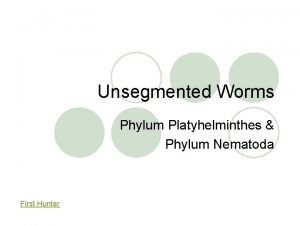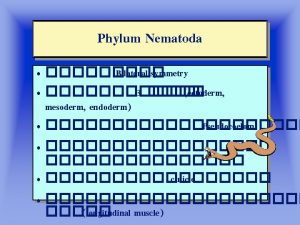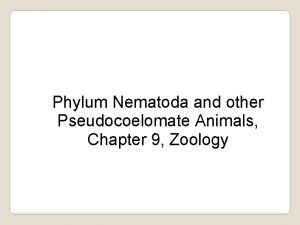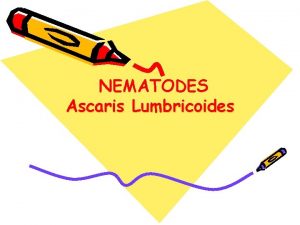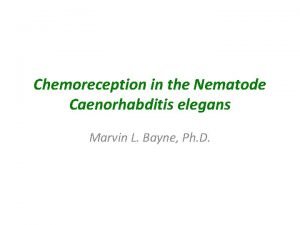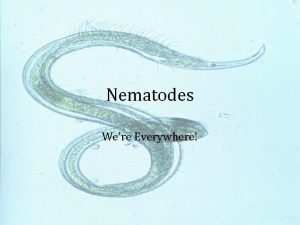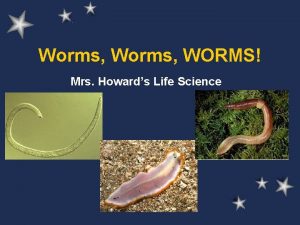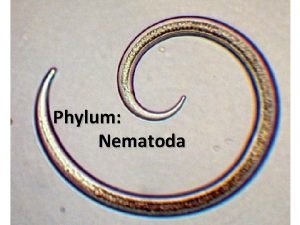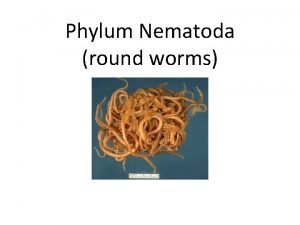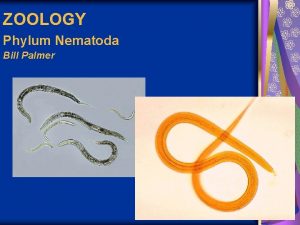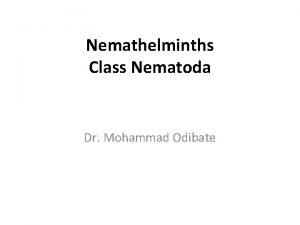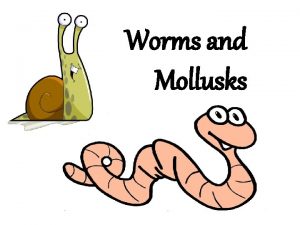Class Nematoda Nematodes Round Worms General characters Nematodes









- Slides: 9


Class Nematoda Nematodes (Round Worms) General characters: • Nematodes comprise the group of organisms containing the largest number of helminth parasites of humans. • They are unsegmented, bilaterally symmetrical without any appendages, and exhibit great variation in their life cycles. • Includes both free-living and parasitic forms. Some can be both free-living and parasitic at times, i. e. Strongyloides stercoralis.

Ascaris Lumbricoides Disease: Ascariasis. Distribution: It is cosmopolitan. Host: Only man. Habitat: Adult worms live in the small intestines. Mode of infection: Infection occurs when the egg containing the infective rhabditiform larva is swallowed. Life cycle: • Fertilized egg passed in feces is not immediately infective. It has to undergo a period of incubation in soil before acquiring infectivity.


• Development usually takes from 10– 40 days, during which time the embryo moults and becomes the infective rhabditiform larva, coiled up within the egg. • When the swallowed eggs reach the duodenum, the larvae hatch out. • Rhabditiform larva penetrate the intestinal mucosa, enter the portal vessels and are carried to the liver. • They then pass via the hepatic vein, inferior vena cava, and the right side of the heart and in about 4 days reach the lungs, where they grow and moult twice.

• After development in the lungs, in about 10– 15 days, the larvae pierce the lung capillaries and reach the alveoli. They crawl up or are carried up the respiratory passage to the throat and are swallowed. • Larvae molt finally and develop into adults in the upper part of the small intestine. They become sexually mature in about 6– 12 weeks and the gravid females start laying eggs to repeat the cycle.

Pathogenesis and clinical picture: Clinical manifestations in ascariasis can be caused either by the migrating larvae or by the adult worms. Symptoms due to the Migrating Larvae: • The pathogenic effects of larval migration are due to allergic reaction (Loeffler’s syndrome). • This ascaris pneumonia is characterized by low grade fever, dry cough, asthmatic wheezing, urticaria, eosinophilia, and mottled lung infiltration in the chest radiograph.

Symptoms due to the Adult Worm: • Asymptomatic infection. a. Improper digestion and absorption of food. b. Fever, urticaria, wheezing, and conjunctivitis. c. Worms may be clumped together into a mass, filling the lumen, leading to volvulus, intussusception, or intestinal obstruction and intestinal perforation. Diagnosis: 1 -Clinically in endemic areas. 2 -Laboratory: -Finding the characteristic eggs in feces. -Adult in vomits or faeces.

Treatment: Albendazole (400 mg once), mebendazole (100 g twice daily for 3 days or 500 mg once), or ivermectin (150– 200 mg/kg once). Prevention and control: Ascariasis can be eliminated by preventing fecal contamination of soil. Proper washing of vegetables eaten raw. Avoid eating raw vegetables. Improvement of personal hygiene. Mass treatment of infected patients. Health education about the hazards and made of infection of the parasite.
